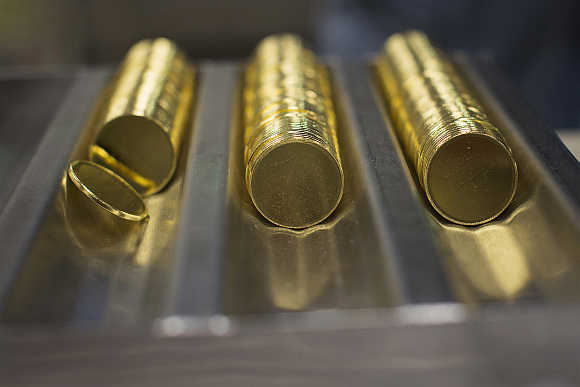
If you invest Rs 1,000 a month for 36 months in Pune-headquartered PN Gadgil Jewellers' gold rush investment scheme, you will be paid Rs 7,000.
That is a return of 19 per cent. You get a return of 12.5 per cent (Rs 3,000) for two years and eight per cent (Rs 1,000) for a year.
Please click NEXT for more...
Please click here for the Complete Coverage of Budget 2014 -15

But the next time you put money in a jeweller's gold saving scheme, you will earn a lower return.
Reason: These schemes have been brought under the definition of deposits under the Companies Act.
So, the effective return cannot be more than 12 per cent and the total amount of deposits has to be within 25 per cent of the company's (other than banks and non-banking finance companies) net worth
Please click NEXT for more...
Please click here for the Complete Coverage of Budget 2014 -15

That would mean a loss of six-seven per cent for investors. Saving schemes of Tanishq, PC Jewellers, PN Gadgil Jewellers and Tribhovandas Bhimji Zaveri will now be deposits, says Ashok Minawala, former chairman of All India Gems and Jewellery Trade Federation.
Earlier, money put in these schemes were seen as advances for future purchase.
"The tenure for these schemes will have to be restricted to a year. Currently, the tenure ranges from one to three years."
Please click NEXT for more...
Please click here for the Complete Coverage of Budget 2014 -15

The new rule is for investor protection as jewellers will be able to take only as many deposits as these can repay.
But the market has many unorganised players who run similar schemes.
These may not come under the rule as all may not be registered as a company.
An expert said, "Many jewellers used the money from these schemes for their business. In a bad market, there were good chances such jewellers may not have been able to repay."
Please click NEXT for more...
Please click here for the Complete Coverage of Budget 2014 -15

Tanishq's vice-president of marketing, Sandeep Kulhali, said it will launch the scheme as soon as they finish wrapping the older one, the deadline for which is August 31.
"We have informed all our customers to close their accounts. They can choose between taking a cheque, coin(s) or jewellery."
If a customer chooses to buy jewellery, he will earn a maximum of 75 per cent of instalments, depending on the number of instalments paid.
If the customer chooses to take a cheque or coin(s), he would earn a maximum of 50 per cent of instalments depending on the number of instalments paid.
Only those who have paid all 11 instalments will get full return. These schemes work like bank recurring deposits
Please click NEXT for more...
Please click here for the Complete Coverage of Budget 2014 -15

Given the scale of the scheme will also be lesser on the back of the new rules, jewellers may have to turn down customers if they cross the 25 per cent mark or ask customers to enrol for smaller instalments.
Says Sajid Mohamed, partner at PDS and Associates, "If a jeweller defaults on payments, there is no way for the customer to ensure he gets his money back. Just that the penalties for this are harsher under the new law, that is, the director can be jailed."
Financial planners suggest bank fixed deposits (low returns but safer) or gold exchange-traded funds over these schemes.
Please click here for the Complete Coverage of Budget 2014 -15